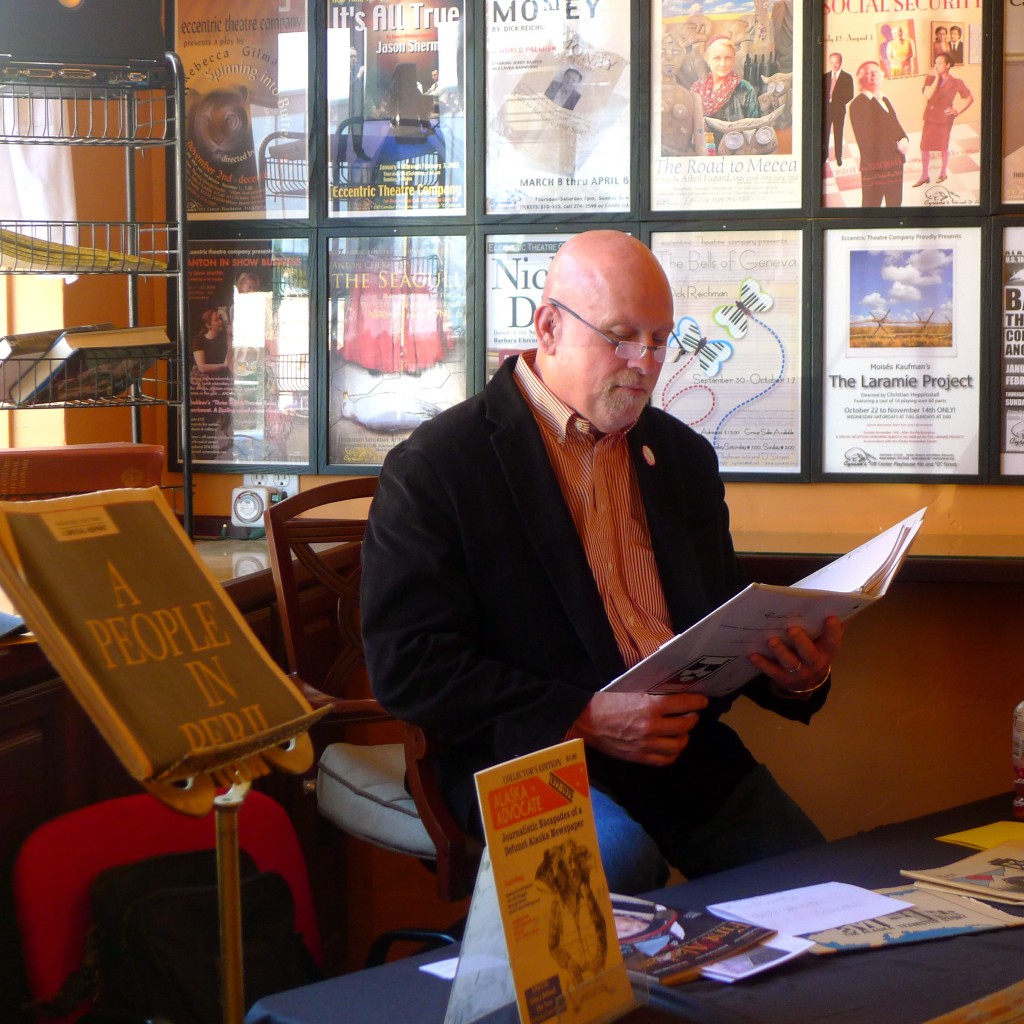“Write Naked,” was Barbara Hodgin’s advice to her husband, Howard Weaver, when he began working on his new book, Write Hard, Die Free: Dispatches from the Battlefield and Barrooms of the Great Alaska News War. Not related to actually writing sans clothes, but about writing that is authentic and unguarded (and infinitely more enjoyable to read).
I had never heard of Howard until the Anchorage Daily News posted an excerpt of his new book: “Cocktails with the Mob.” It piqued my interest, and led me to wandering a few blocks over to Cyrano’s Off-Center Playhouse at lunchtime yesterday for his reading. He selected a chapter titled “The virtues of excess” about the days of the paper he and some colleagues from the Anchorage Daily News launched, called the Alaska Advocate. Here’s a taste:
“It would be fair to characterize much of the behavior at that office as Animal House with better drugs and fewer togas – except, of course, for our devotion to our High and Noble Calling. We took journalism very seriously, but little else.”
John Larson, PBS correspondent, says “Write Hard, Die Free reads like an X-ray of someone with an oversized heart. It’s a story about the battle between good and evil, yet the most stunning portrait is of the author, Howard Weaver – his capacity to care, to fight for things worth fighting for.” You can buy the book at Amazon.
During the reading, I stood next to cartoonist Peter Dunlap-Shohl and watched him sketch Howard on his iPad – I didn’t get to see the finished product yesterday, but thanks to Facebook, I found it this morning when visiting Cyrano’s page. Watching one artist at work while listening to another read his work, both talented, was an unexpected gift.
Another gift is the discovery of such colorful history – I was busy being a kid (and not even born for the beginning) when the newspaper war was waged. Howard’s book brings what to me was a hazy and mostly unremembered time into clear focus, and leaves me wishing for more tales like this; so often history (even recent history) is stripped down to only the facts, or seems written for maximum dryness. Gifted story tellers and teachers (West High’s Mr. McCuthcheon anyone?) bring vitality to the telling, and instead of feeling like you’re dozing off in the back of a classroom, leave you wishing for hours to spend, just listening.
I’ll end with a quote that was the motto of the Alaska Advocate (origin of the quote is murky, but yesterday is the first time I heard it, and it seems fitting for what I know of the book so far – I’ll be reading the rest of it this weekend):
“Sacred cows make the best cheeseburgers”

Good share! I’ll have to get that book, sounds fascinating. I take it that “naked” is the new “gonzo”.
Now what I want to know is what sketching program Peter was using.
Did you check out the sketch on the Cyranos page? So cool! I don’t know Peter at all, but I bet if you go to his blog and ask, he’ll tell you (hyperlinked in the post). Hope you are well!
I remember the newspaper wars well. It is still a surprse that the ADNs “David” beat out the “Goliath” that was the Anchorage Times. My sixth grade teacher, Mrs. Clemmons, had a weekly assignment to compare two different points of view on the same news story. How convenient that our two paper town provided ample fodder everyday. Kay Fanning will forever be the heroine of turbulent times and her own life. I look forward to reading the book. ( submitted inmy PJs).
Thanks for your generous notes about the aid g, Gretchen.
I wrote Write Hard, Die Free mainly in hopes of sharing a story that is important to me with folks to whom it would matter (mostly Alaskans). As you might guess, your characterizations hit pretty close to ground zero for me.
Thanks.
\-\/\/
http://www.howardweaver.com
Thanks Howard! Just taking a break from reading it… wonderful book. I have about three people who want to borrow it when I’m done!
Oops – autocorrect alert: “aid g” is supposed to be “reading”